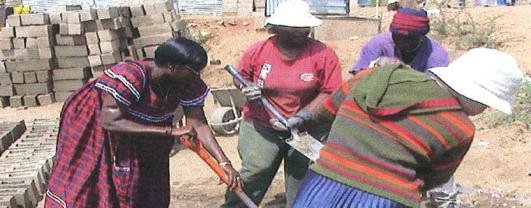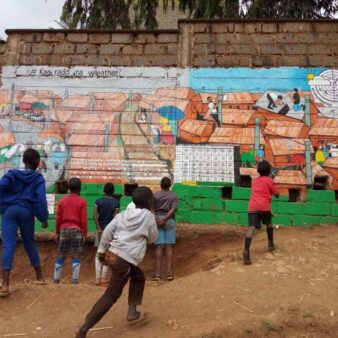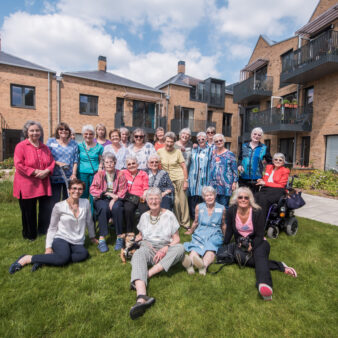Shack Dwellers Federation of Namibia (SDFN) is a network of community-led savings groups working incrementally to secure affordable land, shelter and infrastructure services for low-income urban households across all 13 regions of Namibia. Twenty-two thousand households are currently participating in 434 saving groups enabling these low-income households to access finance, knowledge and understanding of housing processes. Initiated with one project in 1992, 3,200 households to date have secure tenure and 1,350 houses have been constructed at one-third of the cost of conventional housing. The national government now accepts this community participatory approach and is working with SDFN providing funds and access to land.
Project Description
Aims and Objectives
To improve the lives of the poor by securing affordable land and shelter and improving the living conditions of those excluded from commercial housing and financial processes, using a community-driven approach.
Context
With a population of two million, Namibia is a sparsely populated country of small towns and cities. In 2006 over 80,000 households lived in informal settlements in dwellings made of rudimentary building materials. Fifty-six per cent of the population live on less than US$2 a day. Northern development standards were applied irrespective of appropriateness or affordability, making it impossible for poor people to access land or credit to develop decent housing. The HIV/AIDS infection rate of 22.5 per cent is one of the highest in the world. Unemployment is officially stated at 33 per cent, although thought to be nearer 40 per cent, and 40 per cent of the households are women-headed. Following independence in 1990, the government embarked on a national housing strategy known as the Build Together Programme. Through this programme households can access soft loans to construct their own homes. Although more than 10,000 such loans have been given, the very poor could not afford to take out these loans and were still struggling to access affordable land and shelter.
The Shack Dwellers Federation of Namibia (SDFN) is a network of community-led savings groups. Residents in informal settlements started organising savings groups in 1987 in order to improve their poor living conditions and Namibia Housing Action Group (NHAG) was established in 1992 to support this process. The community’s own development fund (the Twahangana Fund) was established in 1996 and the savings groups came together as a national network to form SDFN in 1998. Activities carried out by NHAG/SDFN include supporting small savings groups, capacity building, problem solving and learning facilitated through the community exchanges at local, regional, national and international levels.
Project Details
SDFN has developed an incremental approach to accessing land, adding services and infrastructure and constructing houses. At every stage this process is community-driven. In addition to its advocacy role on behalf of those in housing need, it is now playing an increasing role in the delivery of the national housing policy for low-income households. Low-income communities start their own savings groups and once they have become a member of SDFN, can take out a loan to buy a piece of land. The savings group retains the freehold ownership of the land and each member has a plot, with an agreement setting out their rights and obligations and stipulating who will inherit it. With secure title established, each household occupies its plot, initially with a shack. The building of a new house can begin and an individual water and sanitation connection can be made when the household can afford it. Houses can be constructed at the cost of one-third of conventional housing through community management, household participation in production of building materials, incremental development and accessing land with bulk infrastructure. The cement brick or block houses are 34m2 in size and include one bedroom, a kitchen, a toilet and a shower room. Plot sizes are approximately 180m2, giving space to double the size of the house when needed or affordable.
Twenty-two thousand households are currently participating in 434 saving groups across all 13 regions of Namibia. Each group manages its own savings account and when there are sufficient funds the group can put a deposit on a piece of land. The land is provided by the government and repayments are made to the government for it over a ten year period. To date, 3,200 households have their own plot and 1,350 households have built their own house. The savings groups are different sizes and approximately 73 groups have obtained land and 56 groups have begun construction. The average house loan is N$15,000 (US$2,237).
The savings groups do not act in isolation, but share local knowledge, experiences and teach one another. This knowledge sharing is enabled through regional and area networking, and is critical to empower the poor to take control of their own development. SDFN carries out research and collects information to understand and establish the needs of the communities it serves.
The Twahangana Fund
The Twahangana Fund was established in 1996 as a revolving fund from which individuals can borrow for house construction and provision of services at a five per cent interest rate repayable over 20 years. It also provides income generation loans. The fund also acts as a channel for other sources of funding coming to the organisation, including government donations and housing subsidy funds.
The current total value of the Fund is N$19,553,000 (US$2,916,000), 28 per cent of which has come from external donations, 22 per cent from repayments and interest, 24 per cent from the government housing subsidy programme and 26 per cent as one-off government donations in recognition of the value of the work being carried out.
Covering costs
Local partners and partners from the global North fund the support work of NHAG/SDFN, but the bulk of the finance for acquiring land and developing houses comes from the members’ savings groups and from the government. Northern partners have shown long-standing commitment to supporting the process, and the Namibian government has continued the commitment of an annual payment of N$1,000,000 (US$150,000) to the Fund. SDFN is part of the Government’s National Development Plan, and an estimated 1,000 houses are to be constructed during the next five years. SDFN is beginning to forge new partnerships between commercial institutions and the local communities and in 2007, the Fund secured its first private sector funding from Holcim Cement.
Impact
SDFN has had a significant impact on the lives of low-income urban households in Namibia:
- The approach has been taken up on a national basis. The original housing projects have become a national housing process with over 434 saving groups and 22,000 households participating, covering the majority of the urban areas of Namibia.
- Community savings have reached in excess of N$4 million (US$600,000) and the Twahangana Fund continues to be able to make resources available to those with very low incomes through its Special Fund for those who are terminally ill or disabled.
- 1,350 houses have been constructed and 3,200 households now have secure tenure on community owned land. Low-income households can access finance, knowledge and understanding of housing processes.
- Communities are acting together and are able to access resources that as individuals they would not be able to.
- Women and the most vulnerable have been empowered through active participation in SDFN which has given the opportunity to break away from top-down leadership that had traditionally made people apathetic.
- The Government increasingly accepts community involvement and incremental development approaches. A number of pieces of legislation and policies are a result of the community-driven processes, including the current draft housing policy, the Namibia National Development Plan and the Flexible Land Tenure Bill, which supports community-based land management and scales up the land delivery process with government support.
- The City of Windhoek has recognised that the NHAG/SDFN settlements are not temporary or transit and has permitted the communities to buy blocks of land and carry out incremental development of the site, including putting up shacks (a practice which was previously illegal) until a household has enough funds to start its house.
Why is it innovative?
- Community-driven land and shelter provision has been initiated, adapted and changed to include the very poor and have now extended throughout the entire country.
- The process has been mainly driven by women.
- Conventional planning and design standards and approaches have been challenged and amended in order to make the housing more affordable for those on very low incomes.
- New partnerships have been developed between commercial institutions and the local communities.
- Communities and their local authorities are learning from each other and increasingly working together to address the housing problems faced by low income communities.
- Communities in informal settlements are learning to manage their own data collection through a national community land information programme.
What is the environmental impact?
Environmental sustainability is often not a priority for the poor, due to their immediate need for water, food and shelter. However, NHAG/SDFN encourages opportunities to address these issues. The local production of hollow concrete blocks on site, for example, reduces the need for transport and the planting of trees on individual plots is encouraged. By developing the land themselves, members are flexible in how it is used enabling sensitivity to current environmental features such as large trees and foliage.
A new rainwater harvesting initiative has been introduced as part of a soil protection and flood prevention programme in the hilly areas of Windhoek. The water is used to grow vegetables. This experience is currently being shared with other community groups through the community-to-community exchanges. Old car tyres are also being re-used to help stabilise the soil on a steep site.
Is it financially sustainable?
The majority of the finance for acquiring land and developing houses comes from the members’ savings groups and from the government’s annual N$1 million contribution, channelled through the Twahangana Fund.
The incremental development process allows the members themselves to decide at what point they are able to take out house loans. Some communities decide to pay off the loan for the land and develop the services before embarking on house construction. Before joining SDFN, members frequently have had to pay high rents for their accommodation in back yards and rented rooms, particularly in Windhoek. Under this programme they can construct their own good quality houses for one-third of the cost of conventional housing. This cost saving can be achieved due to a number of factors:
- Construction costs are lower, since communities can use their informal networks to get lower priced materials and can work with their own trained builders and plumbers. Most groups provide free labour for the construction and produce their own hollow concrete blocks on site, thereby saving transport costs.
- Households have flexibility as to when they develop or extend their houses, depending on their family needs and what they can afford.
- By using lower standards (smaller plots, reduced road sizes and affordable sanitation systems), serviced land is secured at a cost of only 60 per cent of fully developed plots in Windhoek and lower in other areas (30 per cent in Walvis Bay). Provision of services by the community is much more affordable than if the local authority carries out the work.
- For those whose income is very low, income generating loans and advice are provided to help households increase their income. Households are permitted to take in lodgers to increase their income, but not to sublet the property.
1,652 small income generation loans of N$500 – N$1,500 (US$75 – US$225) have been provided to members to help them start up or strengthen small businesses and informal trading. Loans are repayable within one year and collateral, if any, is decided by the savings group and not regularised by the Fund itself. To encourage these small businesses, SDFN has built and operated a market for 40 small businesses. Local plumbers and builders are also benefiting from the additional construction work.
Initial funding for the programme came from northern partners (Norwegian Embassy, Deswos in Germany, FCEAR and Intermon from Spain) and the Ministry of Regional and Local Government, Housing and Rural Development (Build Together Programme). In 2007, the Fund secured its first private sector funding (Holcim Cement).
Ongoing institutional maintenance, technical support and capacity building currently cost approximately N$150 (US$22) per member per year. This is funded through local and northern partners, at a cost of N$3 million (US$450,000) per year and there is an on-going commitment to this payment. All SFDN members have recently agreed to pay a small annual contribution of N$10 (US$1.5) to the Fund, thereby enabling it to access funds in the future from the International Urban Fund that Shack Dwellers International (SDI) has established. It is anticipated that 200,000 members will do this, thereby generating US$300,000 per annum.
What is the social impact?
The project makes housing more affordable and increasingly accessible to the very poor, semi-literate, women and the elderly, enabling them to improve their financial position and social standing. Women play a major role in the programme, and have gained confidence in their own abilities and capacity. Communities come together to form savings groups and work closely with one another as they purchase and develop their land.
A major aspect of the project has been to build the capacity of low-income communities to manage their finances in a transparent and accountable way. Sharing their experience with other communities has helped to build a strong national network of savings groups and avoids dependency on service organisations. Training and capacity building are carried out through community exchange and cover a variety of areas, including brick-making, book-keeping, leadership and coordinating and organising a savings group. The exchanges are hosted by the communities themselves and discussions in small groups facilitate direct interaction and learning, allowing participants’ needs to be directly addressed.
Community-to-community learning is combined with the principal of facilitating activities through local ownership that uses non-hierarchical governance structures. This is the cornerstone of empowerment and sustainability in enabling the poor to achieve secure tenure, improved shelter and better access to water and sanitation. SDFN is run by volunteers from the membership, involving as many people as possible. The project has built nine community resource centres which it operates.
As a poor people’s movement, SDFN aims to be as inclusive as possible and has therefore established a special Social Fund to support older persons and those who are terminally ill or disabled. As part of their inclusive approach, NHAG/SDFN does not have a minimum income requirement qualification for people to participate or for minimum amounts to be saved. Emphasis is on small regular savings and taking income generation loans to help increase the economic potential of the poorest households. The very poor are encouraged to build only one room and add to it later.
Barriers
- Initially the poor communities had no confidence in their abilities to lead their own development process. There was a lack of trust of the savings process and a lack of familiarity with participatory decision-making structures. They did not believe the very poor could access land. Regular exchange programmes and active membership participation overcame these problems.
- The high standards expected by local authorities for house construction, as well as the land development process, excluded involvement by the poor. This lack of understanding was overcome through the exchange process, allowing local authorities to develop a greater insight into the process and be flexible in their requirements and standards.
- Higher local taxation levels in Windhoek than in the smaller towns and cities mean that for some households the local taxes are higher than their house repayments.
Lessons Learned
- A community-driven process can result in affordable land and shelter if supported and recognised by local authorities and the national government.
- Knowledge exchange between communities and local authorities ensures development options can be learned and applied from practical examples and direct contact with the various actors and stakeholders involved.
- Community-to-community learning has proved to be more effective than the more formal workshop and training approach that NHAG had used until the mid-1990s.
Evaluation
The performance of the programme is assessed by visitors and partners through observation of the physical improvements in situ, including occupation of land, services and houses. The numbers of active participants in savings groups is reported through national SDFN meetings. Payment and savings performances are reported through regional and national meetings.
Transfer
The SDFN process has demonstrated the viability of replicating activities on a local and national level. SDFN has grown over a period of twenty years and has continually refined its activities in the light of experience. Starting with one small project in 1992, 3,200 households to date have secure tenure and 1,350 households have constructed brick houses and installed services.
Knowledge is shared through community-to-community exchanges. The exchange participants include community members, government and local authority officials and politicians. Officials are mostly at management level, meaning that awareness and ideas are raised and discussed amongst policymakers as well as practitioners. Following exchange visits, 27 Namibian local authorities have made blocks of land available for savings groups to purchase.
International community exchanges are a fundamental part of the programme and are facilitated through the SDI network. Visits are to more than one town and city, and delegates have a chance to meet with national and local government, research institutes and local communities. The Bulawayo Town Council made land available to Zimbabwean saving groups following one such exchange and Malawian authorities have applied the approach to their Slum Upgrading Program. Land was allocated to savings groups and subsequently, 250 houses have been built within a three month period following the exchange.



